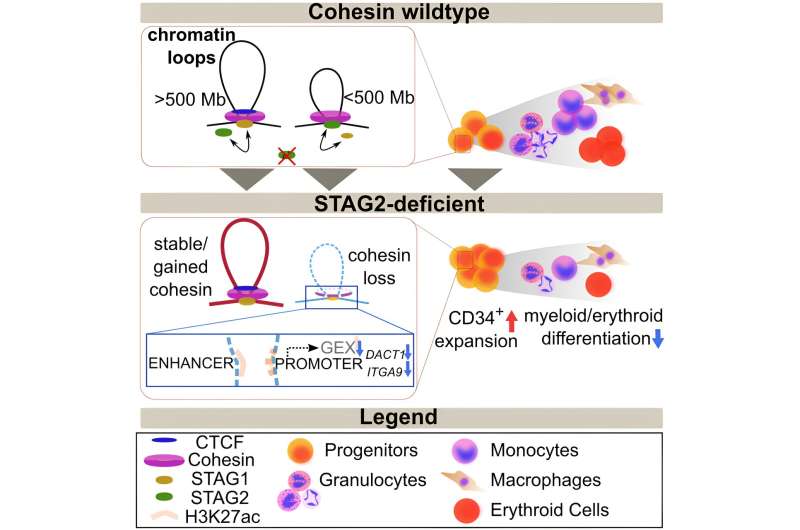This article has been reviewed according to Science X's editorial process and policies. Editors have highlighted the following attributes while ensuring the content's credibility:
fact-checked
peer-reviewed publication
proofread
STAG2 protein mutations and associated spatial alteration of DNA structure can contribute to development of leukemia

Researchers at the Leibniz Institute for Immunotherapy (LIT) studied hundreds of patients with acute myeloid leukemia (AML). They discovered that specific mutations in the STAG2 protein cause altered DNA folding in the cell nucleus, thereby contributing to the development of AML.
The research is published in the journal Cell Reports.
The three-dimensional structure of DNA in the nucleus is stabilized by the cohesin protein complex. It helps to properly fold the DNA and thus regulate gene activity. Cohesin contains two very similar subunits, STAG1 or STAG2. In myeloid leukemias, mutations in the cohesin subunit STAG2 are particularly common, while those in STAG1 are almost never observed.
"We wanted to find out why the STAG2 subunit is so often affected and how a mutation leading to the loss of cohesin complex function could contribute to the development of leukemia," explains Prof. Michael Rehli, the head of the LIT research group.
In collaboration with Prof. Ruud Delwel of the Erasmus Medical Center in Rotterdam, the researchers examined changes in the spatial DNA structure in AML patient samples with and without cohesin mutations. They found that mutations in STAG2 lead to alterations in the DNA structure in AML cells.
These changes impair normal gene regulation, resulting in certain genes being either overly activated or not activated at all. What is particularly remarkable about this discovery is that these disturbances cannot be compensated for by the STAG1 protein, highlighting the role of STAG2 in AML.
In a further step, the researchers examined hematopoietic stem cells from the umbilical cord blood of newborns. These stem cells are precursor cells that can develop into blood and immune cells.
"We deactivated STAG2 in these cells, after which they struggled to develop normally and remained in an immature state—a characteristic typical of AML. Interestingly, this problem did not occur when STAG1 was deactivated instead. This shows how important STAG2 is for the normal development of these cells," explains lead author Dr. Alexander Fischer.
The results illustrate that STAG2 plays a central role in the organization of DNA, the regulation of gene activity, and the differentiation of hematopoietic stem cells into blood and immune cells. Mutations in the STAG2 gene can therefore lead to the development of AML.
"This innovative research provides valuable insights into the molecular mechanisms of AML and could open up new approaches for diagnosis and therapy," says project leader Dr. Claudia Gebhard.
More information: Alexander Fischer et al, STAG2 mutations reshape the cohesin-structured spatial chromatin architecture to drive gene regulation in acute myeloid leukemia, Cell Reports (2024). DOI: 10.1016/j.celrep.2024.114498



















